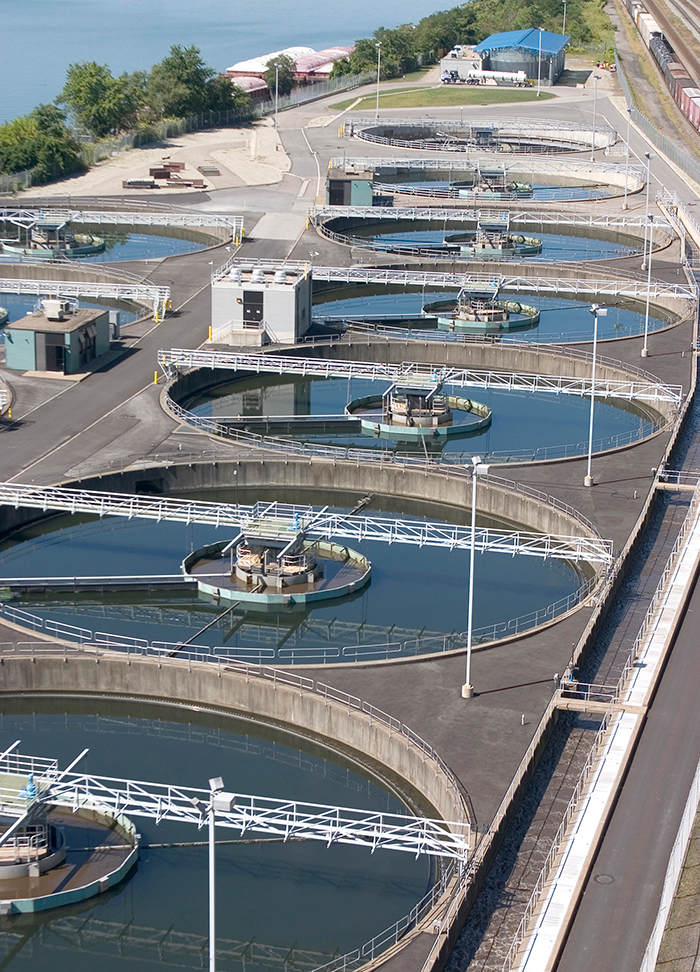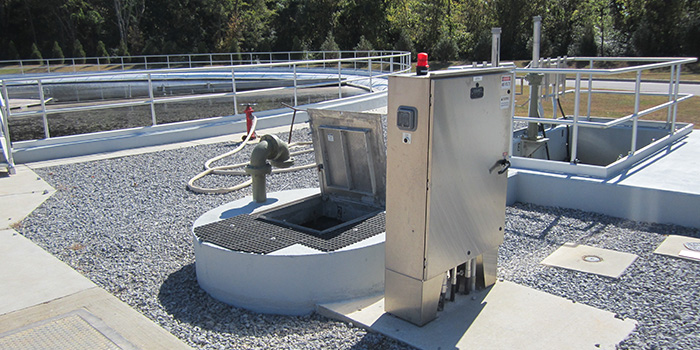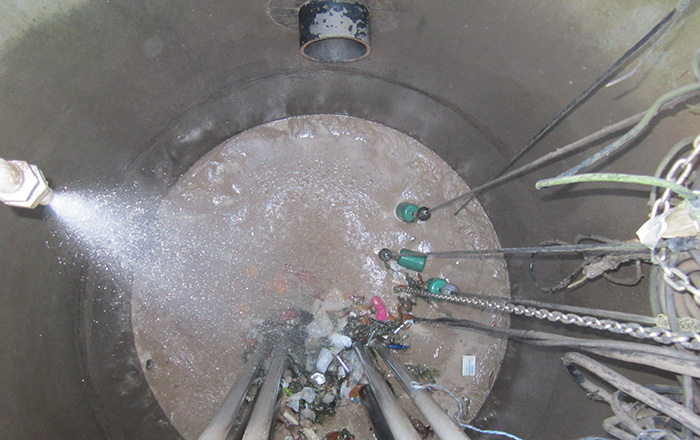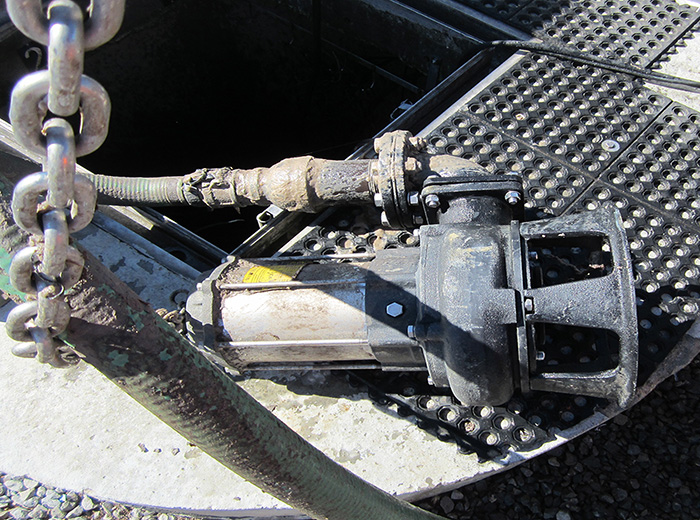Clogs, especially those caused by wipes, can be a major headache for wastewater treatment plants. One city in Minnesota has even filed a lawsuit against makers of “flushable” wipes. Excessive clogging issues at a wastewater treatment plant in Alabama sent the facility’s team on the hunt for a solution to this pressing maintenance issue.
 Image 1. At an Alabama wastewater treatment plant’s pump station, excessive clogging issues caused representatives to search for a permanent solution. (Courtesy of BJM Pumps)
Image 1. At an Alabama wastewater treatment plant’s pump station, excessive clogging issues caused representatives to search for a permanent solution. (Courtesy of BJM Pumps)The small pump station inside the treatment plant contained two grinder pumps in a duplex arrangement, a common arrangement for many wastewater stations. Only one pump is needed to pump sewage out of the station, and the second pump serves as backup. Running the backup pump allows the primary pump to be pulled for service so the plant can achieve continuous operation.
The grinder pumps had been clogging as a result of scum, which flowed into the station from the clarifier. This scum contained a large amount of fibrous material, such as hair, wipes and other consumer products that entered the waste stream. In an effort to reduce debris from the incoming flow, the wastewater treatment plant’s in-house maintenance team installed a basket strainer to catch the solids entering the station. Even after the catch basket was installed, both grinder pumps continued to clog.
 Image 2. The wastewater treatment plant utilized the services of Municipal Consultants Inc., a Birmingham-based engineering group with many years of experience in solving challenges for wastewater pumping stations.
Image 2. The wastewater treatment plant utilized the services of Municipal Consultants Inc., a Birmingham-based engineering group with many years of experience in solving challenges for wastewater pumping stations. The plant manager sought a better solution for handling the solids. A consultant investigated available chopper and shredder pumps, knowing that effective solids-handling would enable the maintenance team to:
Stop pulling the pumps out each week. The maintenance team had to alternately pull up each grinder pump weekly to remove the clogs.
Remove the catch basket. The maintenance team had to clean out the catch basket every day. The sludge had to be removed so the catch basket could continue to collect solids before they could enter the pump.
Spend their time on other maintenance tasks. These clogging problems had continued for about a year, forcing the maintenance team to spend time working on the grinder pumps. If the maintenance team could install a pump that could handle the solids and pump the sludge without clogging, the maintenance personnel would be free to focus on other tasks to support the wastewater plant.
A submersible shredder pump was chosen for numerous reasons. The pump is designed with dual-shredding technology, which employs radial and axial shredding components and has been proven to obliterate solids. A rotating cutter bar with serrated edges traps and shreds solids against the sharp grooves of a radial cutting ring while multiple axial cutting bars shred any leftover material exiting the radial cutters.
 Image 3. The small pump station inside the wastewater treatment plant contained two grinder pumps in a duplex arrangement. Having two pumps in a duplex arrangement is common for most wastewater pumping stations. The maintenance team installed a basket strainer to catch the solids entering the station. Unfortunately, even after the catch basket had been installed, both grinder pumps continued to clog and cause headaches for the maintenance team.
Image 3. The small pump station inside the wastewater treatment plant contained two grinder pumps in a duplex arrangement. Having two pumps in a duplex arrangement is common for most wastewater pumping stations. The maintenance team installed a basket strainer to catch the solids entering the station. Unfortunately, even after the catch basket had been installed, both grinder pumps continued to clog and cause headaches for the maintenance team. All the shredding components are manufactured in hardened 440C stainless steel (Rockwell hardness of 55C plus), which means the pump is constructed to resist wear and operate longer. The pump utilizes a two-vane chrome-iron impeller, which works well for wastewater applications with larger solids. The two-vane design is engineered with “pump out” vanes on its rear shroud to protect the mechanical seal area from a buildup of solids, and the hardened impeller is wear-resistant to lengthen service life.
The pump relies on a high-torque, four-pole motor to ensure that solids-laden wastewater can be moved efficiently. The motor is protected by an oil-lubricated double seal design. An additional lip seal is installed above the impeller to help prevent sludge from entering the seal chamber.
Manufactured with a corrosion-resistant stainless-steel motor housing, the winding protection includes National Electrical Manufacturers Association (NEMA) Class F motor insulation and a built-in motor thermal switch that turns the pump motor off if amp draw or temperature gets too high. The switch resets when the motor cools.
 Image 4. A submersible shredder pump was chosen for its unique hybrid design that features grinding and shredding action. This patent-pending design employs both radial and axial shredding components and has been proven to obliterate solids in wastewater.
Image 4. A submersible shredder pump was chosen for its unique hybrid design that features grinding and shredding action. This patent-pending design employs both radial and axial shredding components and has been proven to obliterate solids in wastewater.The submersible shredder pump shipped to the wastewater treatment plant in July 2015, and the maintenance team promptly placed the pump in the wastewater pump station. The basket strainer installed to catch much of the incoming debris was removed so that the pump could be fully tested.
Because the pump was being evaluated, the wastewater treatment plant did not order guide rails to fully install the pump. The pump was suspended on a chain lowered into the station, with the pump resting on its cage a few inches from the bottom of the 20-foot pit. The maintenance team worked through the process of modifying its 2-inch discharge piping to accommodate the 3-inch discharge connection. The pump did not perform as intended, so the team sought a solution.
While the cause of the performance issues was not confirmed, it was suspected the problem was that the pump was only a few inches off the bottom of the station because the pump’s shredding elements had appeared to be damaged. The problem was resolved by ordering a new set of shredding elements, which included the cutter bar along with radial and axial cutter rings.
After the new cutter bar was installed and all the clearances of the pump had been adjusted, the pump worked perfectly. The treatment plant evaluated the pump for another 45 days and offered overwhelming approval.
In December 2015, the plant ordered the guide rails so the pump could be fully installed. The plant also purchased a second pump and removed the existing backup grinder pump. Once all the equipment was received, the submersible shredder pumps with guide rails and new 3-inch discharge piping were installed in their permanent arrangement.
Both pumps have worked well. The plant’s maintenance team no longer has to perform daily maintenance on the pump station and can better serve other wastewater plant activities.


